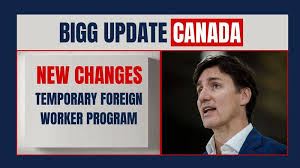Canada introduced significant changes to its Temporary Foreign Worker (TFW) Program. The government’s goal is to prevent misuse of the program and prioritize the employment of Canadian workers. This move reflects the growing concern that the program has been used to bypass local skilled workers in favor of foreign labor. The new rules include shorter LMIA (Labour Market Impact Assessment) validity periods, lower foreign worker caps, and sector-specific exemptions.
These changes impact not only businesses that rely on temporary foreign workers but also foreign nationals seeking employment in Canada. Here, we will discuss each update in detail, explain the purpose behind the reforms, and assess their impact on employers, workers, and the broader Canadian job market.
What Is the Temporary Foreign Worker Program?
The Temporary Foreign Worker (TFW) Program is designed to help Canadian employers address labor shortages by allowing them to hire foreign workers on a temporary basis. This program is particularly useful for industries that experience seasonal or sector-specific shortages.
However, before employers can hire foreign workers, they are required to obtain an LMIA—a document that proves no Canadian worker is available or qualified for the position. The LMIA process is meant to protect the Canadian labor market by ensuring that foreign workers are only hired when necessary. The government has introduced several changes to ensure that this principle is upheld, and that employers are actively prioritizing local talent.
The Role of LMIA
An LMIA is a critical component of the Temporary Foreign Worker Program. It is issued by Employment and Social Development Canada (ESDC) and confirms that hiring a foreign worker will not negatively impact the Canadian labor market. It’s essential for Canadian employers who want to demonstrate that hiring locally has been difficult. This document also serves as a safeguard to ensure that foreign workers are not taking jobs that qualified Canadians could perform.
Concerns Over Misuse of the Program
Over the years, several concerns have been raised about the misuse of the TFW Program. Critics argue that some employers use the program as a way to sidestep hiring skilled Canadian workers, often favoring cheaper foreign labor. This not only undermines local employment but also risks driving down wages for certain sectors.
The Canadian government has responded to these concerns by introducing reforms aimed at reducing over-reliance on foreign workers, particularly for low-wage jobs. The focus is on ensuring that the program is only used as a last resort—when no qualified Canadian workers are available.
Impact on the Canadian Workforce
The changes reflect a broader policy shift aimed at increasing job opportunities for Canadian workers. The government’s goal is to ensure that the TFW Program fulfills its original intent: addressing genuine labor shortages without displacing Canadian talent. By tightening the rules, the government hopes to make sure that foreign workers are only hired when it is absolutely necessary.
Key Changes to the Temporary Foreign Worker Program (Effective September 26, 2024)
Several significant changes are coming into effect with the new regulations. Below, we break down each change and its implications for employers and workers:
1. Labour Market Impact Assessment (LMIA) Restrictions
One of the most notable changes is the restriction on LMIA applications in areas with high unemployment rates. The government will no longer process LMIA applications in the Low-Wage Stream for any census metropolitan area (CMA) where the unemployment rate is 6% or higher. This rule aims to reduce competition for low-wage jobs between foreign and local workers in regions that are already struggling with unemployment.
Exceptions to this rule will apply to industries that are considered essential for food security, such as agriculture, food processing, and fish processing. Additionally, certain construction and healthcare jobs will be exempt from these restrictions. These sectors face persistent shortages, even in regions with higher unemployment rates, making it necessary to continue allowing foreign workers in these fields.
2. Lowered Workforce Cap on Foreign Workers
The Canadian government has also imposed stricter limits on the number of foreign workers that can be hired by employers. The cap on the percentage of an employer’s workforce that can consist of foreign workers in low-wage roles has been reduced from 30% to 10%. This is a significant decrease, and it underscores the government’s desire to prioritize Canadian workers for available jobs.
This change could have a profound impact on businesses that heavily rely on temporary foreign workers, particularly in sectors such as hospitality, retail, and manufacturing. Employers in these industries may need to explore alternative solutions for staffing shortages, such as investing in training and recruitment programs for local workers.
3. Shortened Employment Duration for Low-Wage Workers
Another key change is the reduction of the maximum employment duration for foreign workers hired under the Low-Wage Stream. Previously, foreign workers in low-wage roles could be employed for up to two years. Under the new rules, this period has been shortened to one year. This change is intended to make the hiring of foreign workers a more temporary solution, ensuring that employers continuously seek out local talent to fill positions.
4. Program Review for High-Wage Stream
While the new restrictions primarily target low-wage roles, the High-Wage Stream of the TFW Program is also under review. Over the next 90 days, the government will assess whether similar restrictions should be applied to high-wage positions. This review will include an analysis of unprocessed LMIA applications in this stream, with the possibility of future changes based on the findings.
Additional Measures Introduced in 2023
These latest changes build on a series of reforms that were introduced in October 2023. The following measures have been in place for nearly a year, and they continue to shape the landscape of the TFW Program:
1. Shorter LMIA Validity Period
In October 2023, the government reduced the validity period for LMIAs from 18 months to just 6 months. This change was made to speed up the hiring process and encourage employers to actively search for qualified Canadian workers. The shorter validity period prevents employers from sitting on unused LMIAs, which can delay the hiring of foreign workers and undermine the purpose of the program.
2. Lower Cap on Foreign Workers
Also in October 2023, the cap on foreign workers in low-wage roles was lowered from 30% to 20%. This reduction aligns with the broader effort to minimize reliance on foreign workers and ensure that Canadian employers prioritize local talent.
Quebec-Specific Regulations
The Government of Quebec has introduced even stricter rules regarding the hiring of foreign workers. On August 20, 2024, the Canadian government announced a temporary freeze on LMIA approvals for low-wage positions in Montreal. This freeze is part of an effort to address the high unemployment rate in the city and ensure that local workers have first access to available jobs.
Starting on September 3, 2024, the government has also suspended the processing of LMIA applications for jobs paying below the median wage of $27.47/hour in the Montreal area. Employers in Quebec may need to adjust their hiring strategies and focus more on local recruitment in the wake of these changes.
The Road Ahead: What Employers and Workers Can Expect
The Canadian government is clearly committed to reducing dependence on the TFW Program and ensuring that it serves its original purpose—addressing labor shortages only when no Canadian workers are available. These new restrictions are just one part of a broader effort to boost employment opportunities for Canadians, particularly in low-wage sectors.
For Employers
Employers will need to navigate a more restrictive hiring process, particularly for low-wage roles. The new rules may require businesses to increase their recruitment efforts within Canada, invest in training programs, and rethink their reliance on temporary foreign workers.
For Foreign Workers
Foreign workers seeking employment in Canada under the TFW Program may face more challenges, particularly in low-wage roles. It will become increasingly important to ensure that job offers meet the updated requirements and that employers can demonstrate a genuine need for foreign labor.
In conclusion, the latest changes to the Temporary Foreign Worker Program reflect the Canadian government’s determination to protect its labor market and reduce misuse of the program. Both employers and foreign workers will need to adapt to the new rules, which prioritize Canadian workers and aim to create a more equitable job market.





